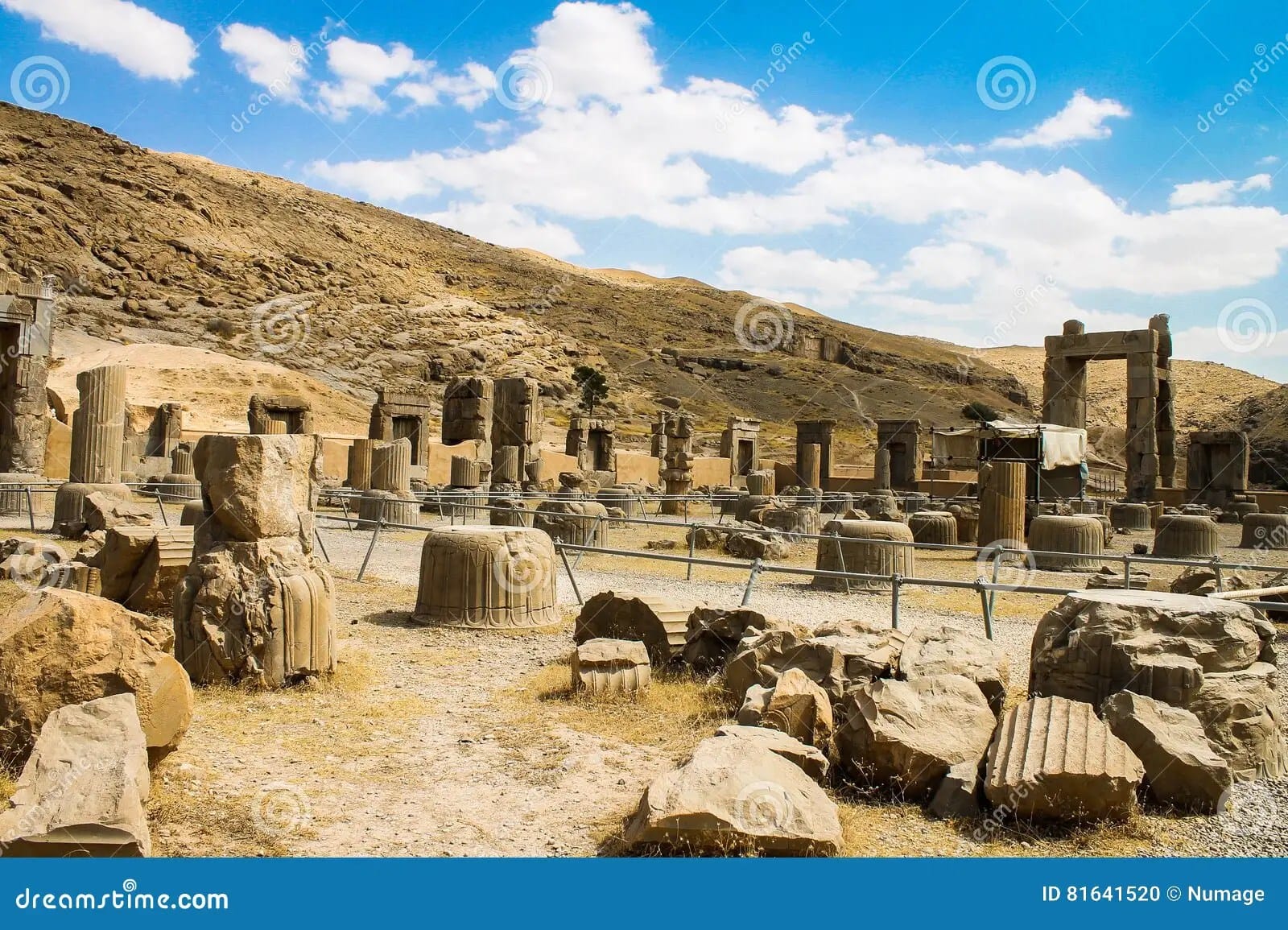Get ready to journey back in time to Takhte Jamshid, the ancient city that once served as the heart of a mighty empire. Located in modern-day Iran, this archaeological gem offers a glimpse into Persia’s glorious past through its breathtaking carvings, monumental structures, and the stories they whisper across centuries.
Unraveling the Majesty: A Closer Look at Takhte Jamshid
Imagine stepping into a world shaped by emperors and artisans, where the very stones whisper tales of Persia’s golden age. That’s the magic of Takhte Jamshid, known to many as Persepolis, the grand ceremonial capital of the Achaemenid Empire.
Building a Dream from Stone: An Empire’s Masterpiece
Our story begins in the 6th century BC with Darius I, a ruler determined to create a city unlike any other. He envisioned Takhte Jamshid as a symbol of his empire’s might, a place to inspire awe and celebrate Persian triumphs. Thus began the construction of this architectural marvel, a testament to ambition and artistry, meticulously carved from stone.
Whispers of a Lost World: Symbols and Stories Etched in Time
Today, the ruins of Takhte Jamshid enchant visitors with intricate carvings that offer a glimpse into a vanished world. The Gate of All Nations, for instance, served as more than just an entrance – it was a powerful statement. Delegations from across the vast empire would have passed through this very gate, their languages and attire reflecting the incredible diversity of the Achaemenid realm.
Look closer at the carvings, and you’ll uncover a language of symbols, a visual feast revealing Persian beliefs and values. Majestic animals, delicate flowers, even the clothing worn by the figures – every detail holds meaning. Lions symbolize power, while the lotus flower, with its delicate petals, represents eternity. It’s like a giant jigsaw puzzle of history and culture, inviting you to piece together its secrets.
From Ashes to Amazement: The Rise, Fall, and Rediscovery of Takhte Jamshid
Even the mightiest empires are not immune to the tides of time. In 330 BC, Alexander the Great marched through Persepolis, leaving a path of destruction in his wake. Consumed by flames, its treasures looted, the once-glorious city was reduced to smoldering ruins. For centuries, Takhte Jamshid lay buried, forgotten by the outside world.
But the story doesn’t end there. Centuries later, tales of a lost city captivated European adventurers and scholars, leading them to stumble upon the ruins of Persepolis. Their discoveries ignited a firestorm of excitement within the archaeological community. Slowly and meticulously, experts from around the world began to piece together the fragments of the past, revealing the splendor of a lost civilization.
A Legacy Etched in Stone: The Enduring Significance of Takhte Jamshid
Today, Takhte Jamshid stands as a UNESCO World Heritage Site, a testament to human ingenuity and a beacon for travelers, history buffs, and those seeking a journey through time. To wander through these ruins is to walk in the footsteps of emperors and artisans, connecting with a past that is both glorious and tragic.
More than just impressive ruins, Takhte Jamshid reminds us of history’s ebb and flow, the rise and fall of empires, and the enduring power of culture. Whether you’re captivated by ancient history, intricate art, or simply seeking an adventure off the beaten path, Takhte Jamshid promises an unforgettable voyage through time.
Unveiling the Ashes: A Deep Dive into the Destruction of Takht-e Jamshid
While the grandeur of Takhte Jamshid is undeniable, its destruction in 330 BC continues to fascinate and spark debate among historians. The event, a pivotal moment in history, saw the glorious capital of the Achaemenid Empire engulfed in flames. While it’s widely accepted that Alexander the Great ordered the city’s burning, the reasons behind his actions remain a subject of much discussion.
Why Did Alexander the Great Destroy Persepolis?
The burning of Persepolis represents one of history’s most debated events. While some scholars suggest that the fire was an accident, possibly ignited during a drunken revelry, others posit more deliberate motivations.
Revenge: The most widely cited theory suggests that Alexander, steeped in Greek culture and history, sought revenge for the Persian sacking of Athens some 150 years prior. The burning of the Acropolis, a significant cultural and religious center for the Greeks, could have fueled Alexander’s desire for retribution.
A Symbolic Act of Conquest: The destruction of Persepolis could have been a calculated move to demonstrate the absolute defeat of the Persian Empire and to solidify Alexander’s dominance. By reducing the empire’s symbolic heart to ashes, Alexander may have aimed to crush the spirit of the Persian people and discourage any future uprisings.
Strategic Considerations: Some historians argue that the burning of Persepolis, while seemingly destructive, could have had strategic value. By eliminating a potential rallying point for Persian resistance, Alexander might have been consolidating his control over the newly conquered territories.
Despite ongoing debate, no definitive answer exists as to why Alexander the Great chose to burn Persepolis. The lack of conclusive evidence ensures that the destruction of Takhte Jamshid, much like the intricate carvings adorning its walls, remains a puzzle for historians and visitors alike to ponder.
Why is Persepolis called Takht-e Jamshid? Unlocking the Secrets of an Ancient Name
Persepolis, the iconic ruins that captivate us today, is a site with two names, each revealing a layer of its fascinating history. While the world knows it as Persepolis, derived from the Greek “Περσέπολις,” meaning “City of the Persians,” its Persian name, Takht-e Jamshid, tells a different story, weaving together history, myth, and a sense of cultural identity.
The Throne of Jamshid: Echoes of a Mythical Past
Takht-e Jamshid, pronounced [ˌtæxtedʒæmˈʃiːd], translates to “Throne of Jamshid,” instantly connecting the site with ancient Persian mythology. Jamshid, a legendary king celebrated for his just rule and extraordinary prosperity, holds a place of honor in Persian folklore. He is said to have possessed a magnificent throne adorned with jewels, a symbol of his power and glory.
It’s likely that during the medieval period, when the ruins of Persepolis were already a source of awe and wonder, the Persian people, drawing upon their rich mythology, began to associate the grandeur of the site with the legendary Jamshid. The image of his magnificent throne would have resonated with the scale and splendor of the ruins, leading to the name Takht-e Jamshid taking root in the collective memory of the people.
This enduring association reveals the power of mythology in shaping how we perceive and connect with the past. The name Takht-e Jamshid adds a layer of mystique to Persepolis, transforming it from mere ruins into a site imbued with the legends and heroes of ancient Persia.
Unveiling Persepolis: The Ancient Marvel of Persia in Modern-Day Iran
The question “Did Persepolis take place in Iran?” often stems from the air of mystique surrounding this ancient wonder. To clarify, Persepolis was not an event, but a magnificent city, the ceremonial capital of the mighty Achaemenid Empire. And yes, it was located in the very heart of what we know today as Iran.
A Legacy Carved in Stone: Tracing the History of Persepolis
Persepolis, known to the ancient Persians as Takht-e Jamshid, served as a symbol of the Achaemenid Empire’s power and grandeur from its construction in the 6th century BC until its destruction in 330 BC. Darius I, the king who initiated the city’s construction, envisioned Persepolis as a place to receive tributes, celebrate victories, and awe visitors with the empire’s wealth and cultural diversity.
For over two centuries, Persepolis flourished as a center of ceremony and celebration. However, its grandeur was not destined to last. When Alexander the Great conquered the Persian Empire, he ordered the city’s destruction, leaving behind haunting ruins that have captivated the world for millennia.
From Ruins to Renaissance: The Rediscovery and Significance of Persepolis
Despite its tragic destruction, Persepolis was far from forgotten. The site, though in ruins, continued to fascinate travelers and scholars throughout history. In the 20th century, archaeological excavations revealed the true extent of Persepolis’s splendor, uncovering intricate carvings, monumental gateways, and the foundations of once-magnificent palaces.
Today, Persepolis, a UNESCO World Heritage Site, stands as a testament to the artistry, ingenuity, and cultural richness of the ancient Persian civilization. It serves as a reminder of both the grandeur that empires can achieve and the transient nature of power. For visitors from Iran and around the world, Persepolis offers a chance to connect with a pivotal moment in history and to witness the enduring legacy of a civilization that forever shaped the course of human history.
















